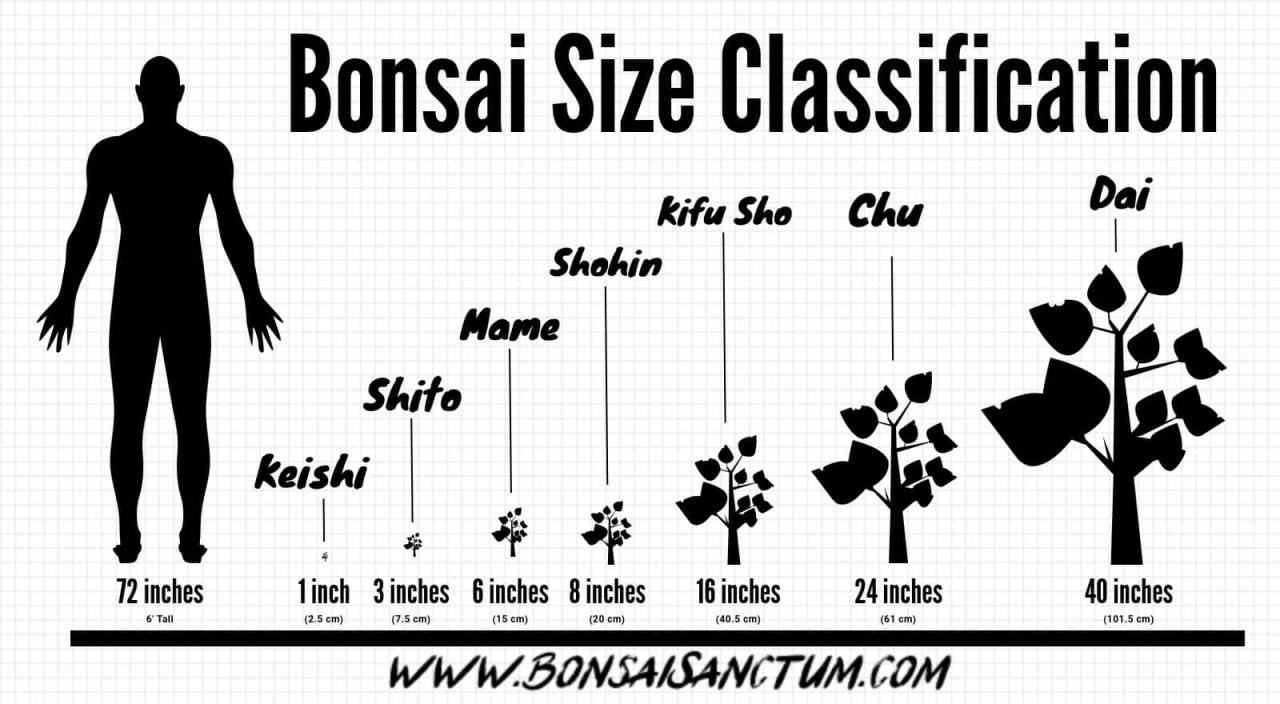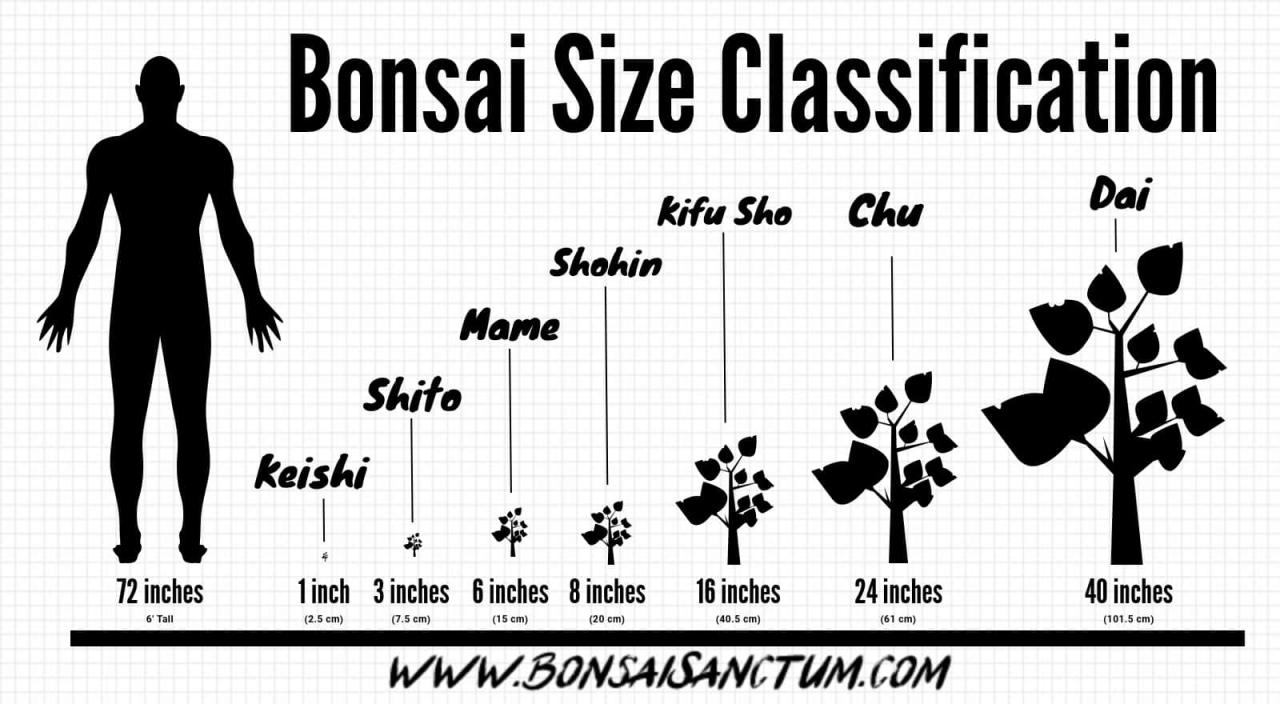Bonsai Pot Sizes: Why It Matters for Tree Growth – more than just a decorative element, the pot plays a crucial role in the health and longevity of your bonsai tree. It’s not just about aesthetics; it’s about creating the right environment for your tree to thrive.
The size of the pot directly impacts the growth rate, root development, and overall health of your bonsai.
Choosing the right pot size is a critical step in bonsai care. Understanding the relationship between pot size and bonsai tree growth is essential for ensuring the long-term health and beauty of your miniature trees. This guide will delve into the factors influencing pot size selection, the effects of pot size on tree growth, and provide practical tips for choosing the right pot for your bonsai.
Importance of Bonsai Pot Size: Bonsai Pot Sizes: Why It Matters For Tree Growth
The size of the pot you choose for your bonsai tree plays a crucial role in its overall health and growth. It’s not just about aesthetics; the pot directly influences the tree’s root system and, consequently, its above-ground development. Understanding this relationship is essential for nurturing a thriving bonsai.
Pot Size and Bonsai Tree Growth
The pot size directly impacts the bonsai’s growth rate. A larger pot provides more space for the roots to spread, leading to faster growth. Conversely, a smaller pot restricts root development, slowing down the tree’s growth. This principle is fundamental to bonsai cultivation, allowing you to control the tree’s size and shape.
Pot Size and Root Development
The size of the pot significantly affects the bonsai’s root system. A larger pot allows for more extensive root growth, while a smaller pot encourages a more compact and dense root system. This is crucial because the root system provides the foundation for the tree’s overall health and vitality.
A healthy root system ensures proper water and nutrient uptake, supporting the tree’s growth and longevity.
Choosing the right bonsai pot size is crucial for healthy tree growth. A pot that’s too small will restrict root development and lead to stunted growth, while a pot that’s too large can cause the soil to stay wet for too long, leading to root rot.
To help you navigate the world of bonsai pots, we’ve compiled a list of the Top 10 Bonsai Pots for Beginners , covering a range of styles and materials. Ultimately, the best pot size will depend on the specific tree species and its growth stage, but understanding these factors will help you choose the right pot to nurture your bonsai masterpiece.
Benefits of Choosing the Right Pot Size
Selecting the right pot size for your bonsai species offers numerous benefits:
- Controlled Growth:By choosing a pot that restricts root growth, you can control the overall size of the bonsai, maintaining its miniature form.
- Improved Aesthetics:The pot is an integral part of the bonsai’s aesthetic appeal. The right pot size complements the tree’s shape and enhances its visual impact.
- Enhanced Health:A well-chosen pot promotes a healthy root system, leading to a more vigorous and resilient bonsai.
- Increased Longevity:By ensuring optimal root development, you can increase the lifespan of your bonsai tree.
Factors Influencing Pot Size Selection
Choosing the right pot size for your bonsai tree is crucial for its health and growth. It’s not just about aesthetics; the pot’s size plays a vital role in regulating the tree’s root system, water retention, and overall development.
Tree Species and Age
The species and age of your bonsai tree significantly influence the appropriate pot size. Younger trees, with their smaller root systems, require smaller pots to encourage faster growth and development. Conversely, mature trees with extensive root systems demand larger pots to accommodate their size and provide adequate space for healthy root growth.
- Younger Trees: Smaller pots promote faster growth by limiting root expansion and forcing the tree to focus on foliage development. This technique, known as root confinement, is a cornerstone of bonsai cultivation.
- Mature Trees: As the tree ages and its root system matures, it requires a larger pot to accommodate its growth. This ensures adequate space for root expansion, preventing rootbound conditions that can hinder the tree’s health and growth.
Bonsai Style and Desired Growth Rate
The chosen bonsai style and desired growth rate are key factors in determining the appropriate pot size. Some styles, like the formal upright (Chokkan), require a deeper pot to accommodate the tree’s upright growth habit. Conversely, styles like the cascade (Kengai) demand a shallower pot to emphasize the tree’s drooping branches.
- Formal Upright (Chokkan): A deeper pot is necessary to provide adequate space for the tree’s upright growth habit. This allows the roots to grow vertically, supporting the tree’s structure and ensuring stability.
- Cascade (Kengai): A shallower pot is preferred for cascade styles, as it emphasizes the tree’s drooping branches and creates a more dramatic effect. The shallow pot encourages root growth horizontally, mirroring the cascading branches.
- Desired Growth Rate: A smaller pot promotes slower growth, while a larger pot encourages faster growth. This allows for precise control over the tree’s development, enabling bonsai enthusiasts to shape and refine their trees according to their vision.
Potting Techniques and Maintenance
Proper potting techniques are crucial for the health and longevity of bonsai trees. The size of the pot significantly influences the amount of soil available for root growth and water retention, impacting the tree’s overall well-being.
Potting Techniques for Bonsai Trees, Bonsai Pot Sizes: Why It Matters for Tree Growth
Potting techniques vary depending on the bonsai tree’s size and the pot’s size. However, certain general principles apply to all bonsai trees, regardless of the pot size.
- Prepare the Pot:Thoroughly clean the pot before planting to prevent the spread of diseases. Ensure the pot has drainage holes to prevent waterlogging, which can lead to root rot.
- Choose the Right Soil:Bonsai trees require well-draining soil with good aeration. A mix of loam, sand, and peat moss is a common choice. The soil should be loose and airy to allow for proper root development.
- Prepare the Tree:Carefully remove the tree from its previous pot, ensuring the root ball is intact. Gently loosen any compacted roots to promote growth. If necessary, prune any damaged or diseased roots.
- Position the Tree:Place the tree in the center of the pot, ensuring the trunk is upright and the roots are evenly distributed. Adjust the height of the tree to achieve the desired aesthetic.
- Backfill with Soil:Gradually add the soil around the roots, ensuring it is firmly packed to provide support. Avoid compacting the soil too tightly, which can restrict root growth.
- Water Thoroughly:After potting, water the tree thoroughly to settle the soil and ensure the roots are hydrated.
Drainage and Aeration in Bonsai Pots
Proper drainage and aeration are essential for the health of bonsai trees. Drainage prevents waterlogging, which can lead to root rot, while aeration allows for proper root development and oxygen exchange.
Bonsai pot size plays a crucial role in determining the health and growth of your miniature tree. Choosing the right pot size is essential for maintaining a healthy root system and promoting balanced growth. To ensure your bonsai thrives, it’s important to select a pot that suits its specific needs, such as its size, style, and growth habit.
How to Choose a Bonsai Pot That Suits Your Tree’s Needs provides a comprehensive guide to help you make an informed decision. By considering the pot size and its impact on root development, you can provide your bonsai with the optimal environment for long-term health and beauty.
- Drainage Holes:Bonsai pots should have adequate drainage holes to allow excess water to escape. The number and size of the drainage holes should be appropriate for the size of the pot.
- Pot Material:The material of the pot can also influence drainage and aeration. Pots made from porous materials like terracotta allow for better drainage and aeration than glazed pots.
- Soil Mix:The soil mix used for bonsai trees should be well-draining and aerated. A mix of loam, sand, and peat moss is a common choice, providing a good balance of water retention and drainage.
Maintenance Tasks Related to Pot Size and Bonsai Tree Health
Regular maintenance tasks are crucial for maintaining the health and longevity of bonsai trees. These tasks include:
- Repotting:Bonsai trees need to be repotted every 2-3 years to refresh the soil and prune the roots. The frequency of repotting depends on the tree’s growth rate and the pot size.
- Watering:Bonsai trees require frequent watering, especially during the growing season. The frequency of watering depends on the pot size, soil type, and weather conditions. Water deeply when the soil is dry to the touch.
- Fertilizing:Bonsai trees benefit from regular fertilization to provide essential nutrients. The type and frequency of fertilization depend on the tree’s species and growth stage.
- Pruning:Regular pruning is essential for maintaining the bonsai’s shape and size. Pruning should be done throughout the year, focusing on removing dead, diseased, or overgrown branches.
- Pest and Disease Control:Bonsai trees are susceptible to pests and diseases. Regularly inspect the tree for signs of infestation or disease and take appropriate measures to control them.
Final Wrap-Up

Mastering the art of bonsai involves a deep understanding of the delicate balance between the tree and its environment. By understanding the significance of pot size and its impact on root development, growth rate, and overall health, you can create a thriving bonsai that will bring beauty and tranquility to your home for years to come.
Remember, the right pot size is not a one-size-fits-all approach. It’s about careful observation, understanding your bonsai’s specific needs, and making informed choices to ensure its long-term well-being.
Query Resolution
What are the signs of a bonsai tree being in a pot that is too small?
Signs that your bonsai is in a pot that’s too small include stunted growth, yellowing leaves, and roots emerging from the drainage holes.
How often should I repot my bonsai?
Repotting frequency depends on the bonsai species and its growth rate. Generally, young trees need repotting more often, while mature trees may only need it every few years.
What is the best material for bonsai pots?
Bonsai pots can be made from various materials, including ceramic, clay, plastic, and wood. The choice depends on your personal preference and the specific needs of your bonsai.
